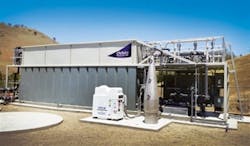Moving Beyond Septic
About the author: Dennis Livingston is director, MBR systems, for Ovivo. Livingston can be reached at [email protected] or 512.834.6019.
An Indian reservation in the Sierra Nevada mountain region in California was experiencing septic system failure that posed severe environmental and health risks for the tribe and local businesses. More than 30% of the region’s septic tank and drainfield systems had failed and an additional 30% was predicted to fail in the near future. The tribe’s failure rate significantly exceeded the U.S. Environmental Protection Agency’s reported national average of 10% to 20%.
As a result of the failing systems, the untreated wastewater was entering neighboring homes and needed to be pumped out to help manage the contamination. In addition to the residential challenges, the overflowing wastewater was permeating into rivers and streams without being treated, potentially leading to waterborne diseases and other health and safety concerns.
To address the issue, the tribe required a new approach from a variety of teams and resources to collaborate on support, knowledge and funding that would allow it to improve the quality of life on the reservation. It also needed to utilize the skill sets of tribe community members to independently manage and operate the new treatment solution.
Packaged Plant Solution
After a series of design and engineering considerations, the Ovivo microBLOX ready-to-operate process-intensified membrane bioreactor (MBR) system was determined to be the best option for the unique challenges and requirements of the tribe. The system was chosen for its small footprint, ease of installation and operation, and the ability to scale for future expansion in providing treatment for more than 850 residents and commercial properties, including a casino.
The MBR system was developed as a flexible zoned packaged plant that incorporates a single-process, high-mixed-liquor-suspended-solids MBR design with concentrated oxygen to intensify the treatment process. The single-process zoned approach with digital integration in the microBLOX system offers the tribe the following advantages:
- Easy operation and maintenance with components that are easily accessible;
- Simple technology that increases treatment capacity in the same space while reducing hauling frequency;
- An immediate fix to a significant problem with quick delivery and a ready-to-operate design; and
- An enhanced digital platform to help manage the microBLOX system and maintain plant efficiency.
Self-Sustaining Plant
Installing the MBR packaged system had an immediate impact on the tribe community. Failing septic tanks are being decommissioned and residential homes are connecting to the microBLOX system at a flow rate of 75,000 gal per day. The plant was designed for expansion so that a greater number of homes and businesses will be brought together on the same system in a phased approach to accommodate higher flows.
Sufficient training and continued support from the manufacturer ensured that the tribe was set up for long-term success. This has allowed the tribe to move away from septic systems and operate as an independent, self-sustaining plant.
Download: Here
